Fuchsia Plants
"Fuchsias are a garden essential, offering an abundance of elegant, pendulous blooms from early summer to the first frosts. Whether cascading from baskets, brightening patio pots, or adding structure to borders, they deliver vibrant colour with minimal effort. Easy to grow and incredibly floriferous, they thrive in a mix of sun and shade, rewarding you with months of continuous flowers."
Peter McDermott, Head Gardener
OFF
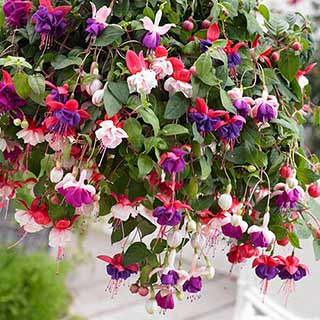
OFF

OFF


OFF
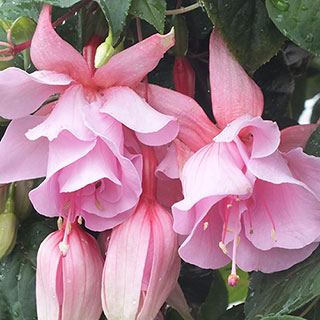
OFF
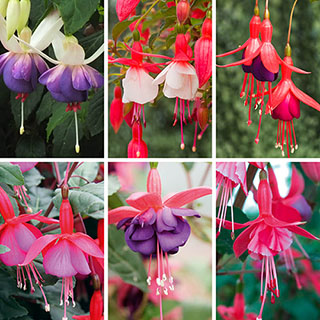
OFF

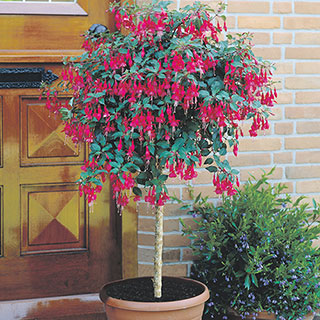
OFF
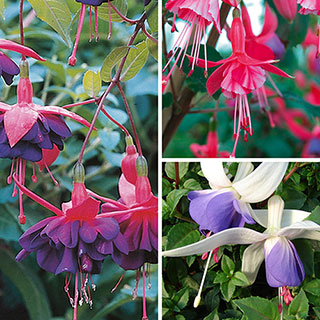

OFF
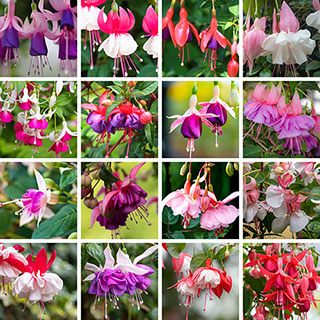
"Fuchsias are a garden essential, offering an abundance of elegant, pendulous blooms from early summer to the first frosts. Whether cascading from baskets, brightening patio pots, or adding structure to borders, they deliver vibrant colour with minimal effort. Easy to grow and incredibly floriferous, they thrive in a mix of sun and shade, rewarding you with months of continuous flowers."
Peter McDermott, Head Gardener
Fuchsia plants are popular for summer flowers in borders, plant pots and hanging baskets. They have attractive delicate pendent shaped flowers which come in a variety of different shades of pink and purple, often with highlights of white. With the correct care these beautiful flowers can bloom year after year.
There are a huge number of fuchsia varieties available including ones with jumbo flowers, trailing fuchsia plants and an enormous range of colours too. They usually grow to about 50cm and bloom all through the summer guaranteeing you a really colourful display. Flowers will die off with the first sign of frost, unless you choose a really hardy variety.
When to Plant Fuchsias:
Fuchsias are best planted in the late spring or early summer once the risk of frost has passed. This allows them to establish their roots before the warmer months ahead. In colder regions, it is advisable to wait until all danger of frost has passed and the soil has warmed up.
Growing Fuchsias
Fuchsias plants prefer a partially shaded spot in your garden. Look for an area that receives morning sun and afternoon shade, as direct sunlight can scorch their delicate foliage. Avoid planting fuchsias in windy locations, as strong winds can damage their branches and flowers.
Prepare a well-draining compost and soil mix rich in organic matter for your fuchsias. They thrive in soil that is slightly acidic to neutral. Incorporate compost or well-rotted manure into the soil before planting to improve its structure and fertility. This will provide the necessary nutrients and ensure good drainage for healthy root development.
When planting fuchsias, dig a hole that is slightly larger than the root ball of the plant. Gently remove the plant from its container, being careful not to disturb the roots. Place the plant in the hole, ensuring that it sits at the same depth as it was in the container. Backfill the hole with soil and lightly firm it around the base of the plant. Water thoroughly to settle the soil and encourage root establishment.
Fuchsias appreciate consistent moisture, so ensure that they receive regular watering. However, it's crucial not to overwater them, as excessive moisture can lead to root rot. Monitor the soil moisture levels and water when the top inch of soil feels dry. Additionally, apply our blooming fast fertiliser during the growing season to provide the necessary nutrients for healthy growth and abundant blooms.
Regular pruning is essential to maintain the shape and promote bushier growth in fuchsias. After the plant has finished blooming, prune back any leggy or weak stems, leaving about one-third of the plant intact. This will encourage new growth and increase flower production. Remove spent flowers regularly to promote continuous blooming.
Can you eat Fuchsia berries?
Not many people realise that the fuchsia plant has edible fruit. However, the taste of the fruit varies from being almost tasteless to having an unpleasant aftertaste. The fruits can make good jam, but make sure you check if the varieties you have are the ones with the tasty berries. The easiest way to buy them is as fuchsia plug plants.

